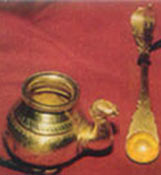 |
Gold
gindi & uddharane |
|
The large circular plate
containing the five ritual vessels, panchapatre,
then gindi and the uddharane is
placed in front of the image in the sanctum on a
stand close to where the priest offers worship.
Made out of brass, bronze,
silver, or white metal, the legs of such tripods
are shaped like those of an elephant to give it
solid support. The Parakala Mutt, Mysore, possesses
a large silver tripod with an inscription recording
this gift in the service of the god Hayagriva by
Krishnaraja Wodeyar III The record is not dated.
|
